In-Depth with Mac OS X Lion Server
by Andrew Cunningham on August 2, 2011 8:00 AM ESTA directory isn’t much good to anyone without any objects in it, so we’re going to create a few users and groups to test things out. As with creating a directory, there are a couple of different ways to do it.
In Server.app: Use the plus sign to add new users in the Users section - you can enter their full name, email address, and desired password here, which covers most of the account basics.
Directory accounts (as opposed to accounts local to your server) will appear with a circular blue globe icon next to their names.
Clicking the gear icon will allow you to edit the user’s properties (including the full name, email address, whether he or she can administer the server, and group membership - the user’s short name isn’t changeable after it’s set), as well as edit the services that user can use (making it easy to keep, say, mail or VPN access off-limits to guest users).
Start Workgroup Manager and authenticate using the Directory Administrator privileges you specified when you created your directory. The window you’ll see is a bit scarier than what you get in Server.app.
The four tabs above the left-hand column are for users, user groups, computers, and computer groups - if you made some users or user groups in Server.app before, they’ll show up here, too, and you can enter a lot more info in Workgroup Manager than in Server.app. There’s too much to go into in a general review, but this screenshot will give you an example of the detail you can go into:
The main thing you can do with Workgroup Manager that you can’t do with Server.app is manage OS X preferences - everything from the icons in the Dock to what applications your users are allowed to launch. If you select a user or group or other entry, you can click the Preferences button to see all of your options.
Settings in here are roughly analogous to those in System Preferences in any ol’ Mac.
Workgroup Manager is a powerful tool for managing users and settings, but like many of the other longtime OS X Server standbys, it’s on the road to being deprecated. The preferences managed in Workgroup Manager are mostly to be used for Macs running pre-Lion versions of OS X. Lion (and also iOS) clients are best managed with a tool new to Lion Server: Profile Manager.
Directory accounts (as opposed to accounts local to your server) will appear with a circular blue globe icon next to their names.
Clicking the gear icon will allow you to edit the user’s properties (including the full name, email address, whether he or she can administer the server, and group membership - the user’s short name isn’t changeable after it’s set), as well as edit the services that user can use (making it easy to keep, say, mail or VPN access off-limits to guest users).
Editing a user
Controlling access to services
Under the Groups header, you can create and modify your groups and their memberships. If you’re running the Wiki or iChat services, you can make group-specific wikis and make group members appear automatically on each others’ buddy lists.
The second, more advanced way to edit users and groups is to use Workgroup Manager, another of the Server Admin Tools. Like Server Admin, this used to be the go-to tool for managing not just users and user groups, but also computers and computer groups - managing settings on a computer or computer group basis can be useful if you’ve got web kiosks or computer labs (for instance) that you want to act differently than standard workstations for users who log into them.Start Workgroup Manager and authenticate using the Directory Administrator privileges you specified when you created your directory. The window you’ll see is a bit scarier than what you get in Server.app.
The four tabs above the left-hand column are for users, user groups, computers, and computer groups - if you made some users or user groups in Server.app before, they’ll show up here, too, and you can enter a lot more info in Workgroup Manager than in Server.app. There’s too much to go into in a general review, but this screenshot will give you an example of the detail you can go into:
The main thing you can do with Workgroup Manager that you can’t do with Server.app is manage OS X preferences - everything from the icons in the Dock to what applications your users are allowed to launch. If you select a user or group or other entry, you can click the Preferences button to see all of your options.
Settings in here are roughly analogous to those in System Preferences in any ol’ Mac.
Workgroup Manager is a powerful tool for managing users and settings, but like many of the other longtime OS X Server standbys, it’s on the road to being deprecated. The preferences managed in Workgroup Manager are mostly to be used for Macs running pre-Lion versions of OS X. Lion (and also iOS) clients are best managed with a tool new to Lion Server: Profile Manager.


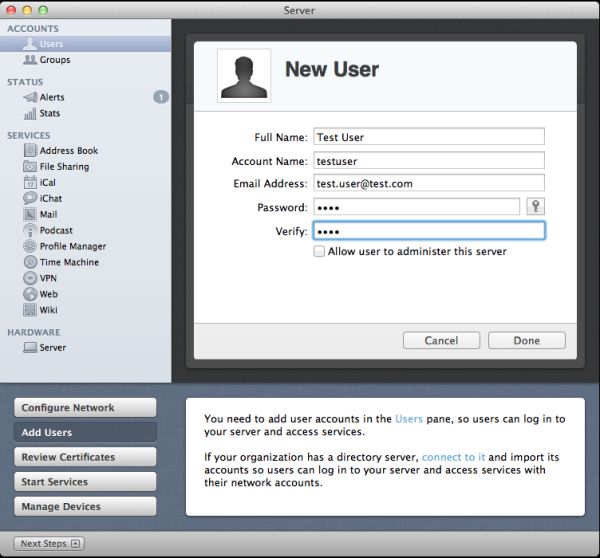
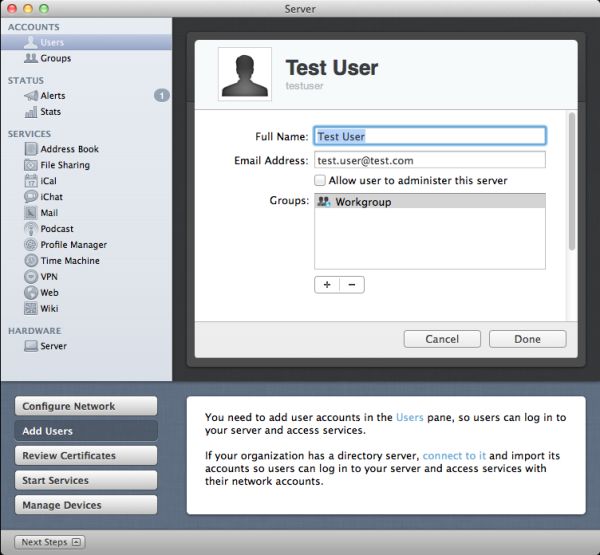
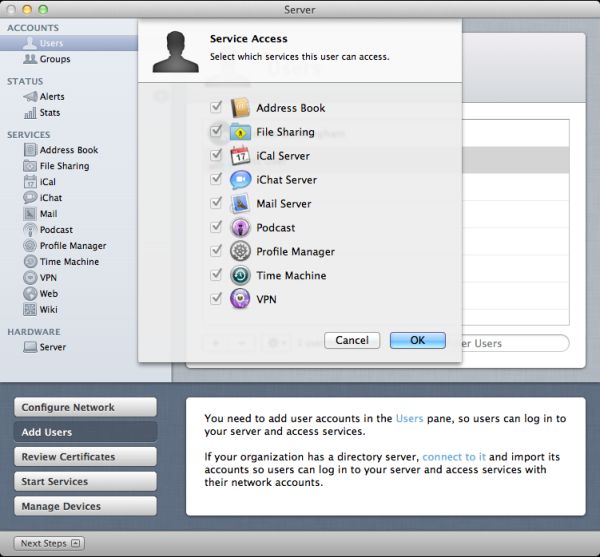
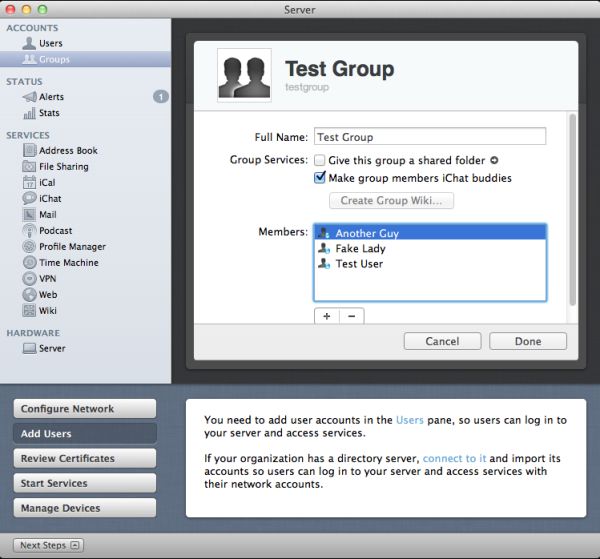
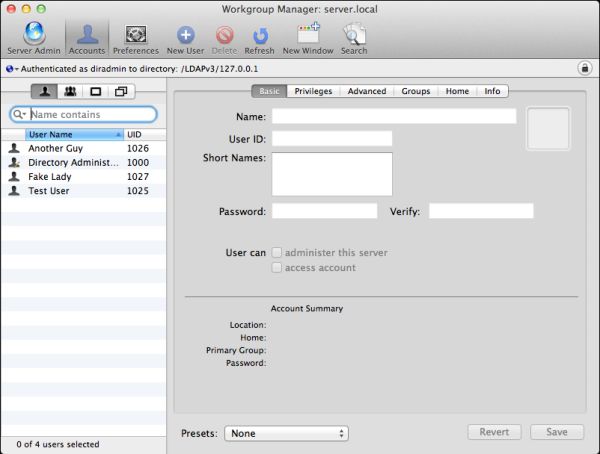
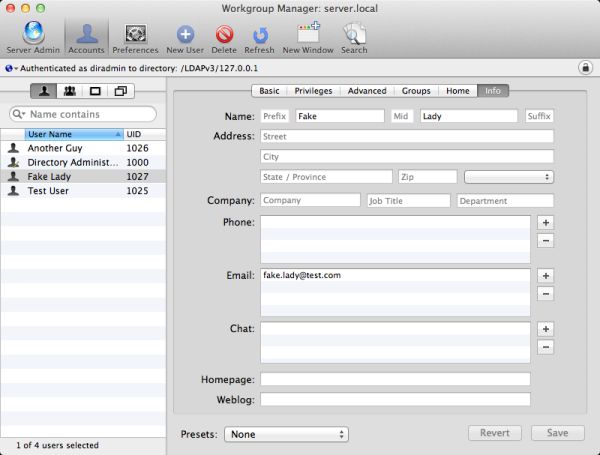
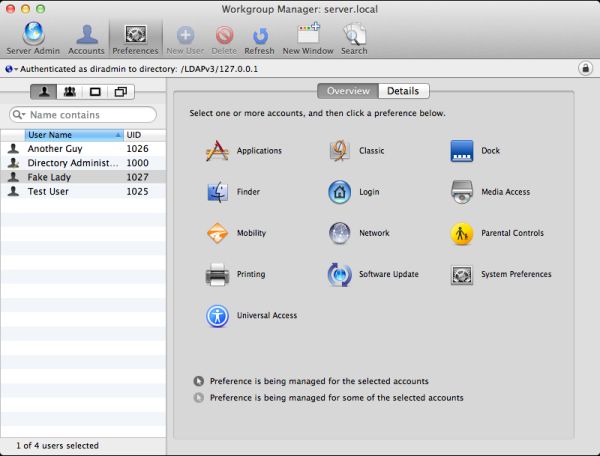








77 Comments
View All Comments
HMTK - Wednesday, August 3, 2011 - link
OK so you can definitely run a Mac OS X vm on vSphere 5 but only on Apple hardware. What a joke! Probably Apple idiocy rather than a technical limitation.Spazweasel - Wednesday, August 3, 2011 - link
Apple is a hardware company. OS/X and iOS exist to make hardware sales possible (thus the cost of development is included in the pricing for Apple hardware, something the Apple haters conveniently overlook) Allowing the running of OS/X on non-Apple hardware reduces Apple hardware sales, so they don't do it."Idiocy"? Yeah, sure, whatever.
HMTK - Wednesday, August 3, 2011 - link
Not allowing Mac OS to run under a hypervisor on non-Apple branded hardware won't help them either. Or do you think a halfway decent IT-department would put a desktop machine or a hard disk posing as a server in a data center? They'd rather pay a few 100 € more for a license if they could run it on ESXi/XenServer/Hyper-V and reliable hardware.Spazweasel - Wednesday, August 3, 2011 - link
Apple makes its money on the desktop, not the server room. I doubt it's worth the effort. OS/X in the server room is a niche product, and Apple know it; it's much more suited as a workgroup/small office server, and those environments do not have ESX or Xen installations.Apple has no incentive to support OS/X in a VM, and plenty of reasons not to. Really, I don't see why this is a surprise.
HMTK - Thursday, August 4, 2011 - link
I'm not saying it's a big surprise, I'm saying it's stupid. why not make good manegement tools for their iOS available in a way that companies can integrate better in their infrastructure?You might be surprised as to how many small shops are going the virtualization route. Even if you have only a single server it makes sense in the long run when the time comes to replace the hardware. Just import the VM on the hypervisor on the new hardware and you're done.
GotThumbs - Tuesday, August 2, 2011 - link
This is an interesting article and I enjoyed the depth of detail. As a builder of my own systems for years, does the use of this software bind you to using only a ready built Apple system? It seems Apple is slowly trying to create a close proprietary system where you have to use apple hardware and apple software. I know their are hackintosh systems but it seems its still going to be quite a bit of effort and so far seems to be a waste of time for me. As the article mentions, there are lots of alternatives available. Apples MO seems to be offering zero options for using outside sources. Apple consumers are being channeled to Itunes and the Mac App Store for all purchases. I'm personally not a fan of that trend and have no intentions of bowing down to that kind of control. I can see where the general consumer who has very little technical knowledge is quite accepting of Apples controls as its a very simple and somewhat brainless system packaged in a slick looking package.GrizzledYoungMan - Tuesday, August 2, 2011 - link
Or is it still something we're all going to pretend works, when it very clearly doesn't out in the real world (If it worked, why would DAVE exist)? I'm referring here to the myriad of permissions issues and oodles of useless garbage sidecar files that pop up after a few days of operation in a mixed environment.Haven't read the article. Probably won't. Sorry. Apple is a joke at anything that designing anything that doesn't fit in your pocket/surrogate vagina of choice.
I get this feeling, deep in my angry muscle, every time some imbecile waves around his iThing, raving about Apple's genius, while I'm thinking about all the time that has been wasted trying to get OS X desktop clients to do things that have worked out in the real world for years now.
blueeyesm - Tuesday, August 2, 2011 - link
Not in Lion, as Samba moved to GPL3 licensing.http://www.appleinsider.com/articles/11/03/23/insi...
GrizzledYoungMan - Tuesday, August 2, 2011 - link
You know what's wild? I should actually be excited they're moving to a new standard - the NAS' I often recommend to clients support SMB2, and see useful performance gains from it.But then I read "Windows networking software developed by Apple" and my heart sinks. Realistically, what are the odds this is going to work?
Honestly, I don't really blame the design teams over there so much as a closed corporate culture that both ignores the feedback of their customers and denies any complaints exist.
They're really missing out on the sorts of improvements that most big software developers make using the information gathered during large, open betas and the like.
repoman27 - Tuesday, August 2, 2011 - link
As the article you linked to points out, since version 10.2 Mac OS X has shipped with Samba, an open-source, reverse engineered version of SMB 1.0. With Lion, Apple dropped Samba and added native support for SMB2 while maintaining the ability to connect with SMB 1.0 machines as long as they use UNICODE and extended security. This means Mac OS X 10.7 can no longer connect out of the box with some SMB 1.0 or Samba machines (which it had done for the last 9 years), but it does have full support for SMB2.As for GrizzledYoungMan's "oodles of useless garbage sidecar files," it's not like Mac users have any use for a thumbs.db file either. Just hide the metadata files, or don't allow write permissions on the folder if you don't want to see that kind of stuff, but these types of files are most likely only going to become more prevalent as time goes by.